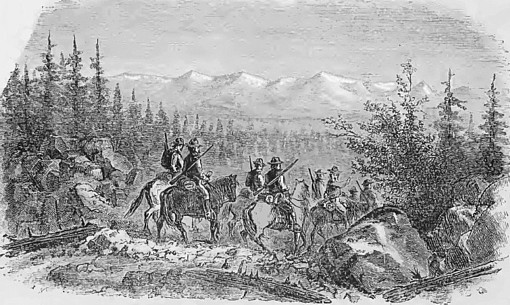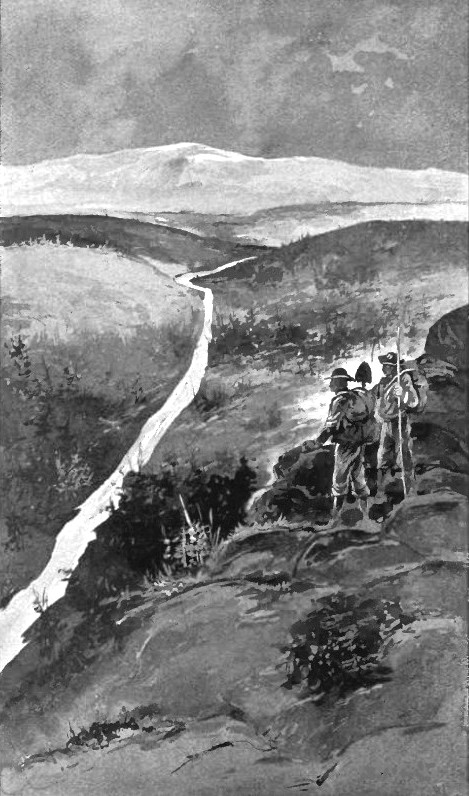Eight miles east of Baker City is the famous Virtue mine, which has shown that "Virtue is its own reward" by producing over $3,000,000. Its gold ore is so absolutely free-milling that 95 per cent, of its value is saved by the simplest amalgamation process, and the remainder by concentration. The ore mills from $15 to $25 to the ton; but, as depth is attained, it grows richer. In the mineral show-window of the Oregon Railway and Navigation Company's Portland ticket office there are now on exhibition some samples of ore from a recent strike in the Virtue mine that have attracted no end of attention. They are not mere chips or specks, but are what an old miner would style "big chunks," of ore that runs from $100,000 to $200,000 to the ton! From a five-pound lump of it, $500 could be pounded in a few minutes with a mortar and pestle! The specimens are locked up in the big office-safe at night, like money or jewelry. The ore-body is opened up on the 300-foot, 470-foot and 600-foot levels, and a shaft has just been driven down to a depth of 700 feet. The main pay-chute, so far as explored, is 800 feet long, and averages 3 feet in width.
The mine is equipped in the best modern style, with a 20 stamp mill, hoisting-works, pumps and concentrating-plant. The capacity of the mill is to be doubled this season, giving it 40 stamps, and there is ore enough in sight to run it for years. The output now is from $20,000 to $30,000 a month, and it is only limited by the capacity of the machinery. Adjoining the Virtue on the south is the Consolidated Virginia, on which work is being pushed as rapidly as men and money and the most improved machinery can do it, to reach the Virtue vein. The Mogul, Gold Dollar and Texas groups lie north and northeast of the Virtue. The Emma-Monte, just north of the Texas, has struck ore that mills over $25 to the ton. North of the Emma-Monte is the Perry, at a depth of 200 feet, producing ore that mills from $5 to $20 to the ton. The Rachel joins the Perry on the north, and has thousands of tons of ore opened up that will mill from $5 to $30.
The Alturas and Del Norte, north of the Rachel, have struck good ore that differs in character from that of the district generally in not being free-milling. The Flagstaff, in the northwest part of the Virtue belt, is owned by a French company, that has a splendid equipment of steam hoist, eight compressed-air drills and a lo-stamp mill. Its shaft is down nearly 600 feet, and drifts have been run at the 100, 200 and 300-foot levels, opening up an ore-body from 200 to 400 feet long, and running from $3 to $50 to the ton. Good prospects have been found on the Cyclone, Red Jacket, Gordon, Lady, Adams, Phillips, Bradbury, Butler, McCord and many other claims in the same neighborhood.
The White Swan, three miles east of the Virtue, has produced over $300,000, and paid for all development and improvements, and $40,000 in dividends, without the investment of a dollar. The ore is all free-milling, and runs from $6 to $25 to the ton, averaging $14. A few tons of surface ore from the Mabel, two miles southwest of the White Swan, yielded $24,000 in gold, and development work is being pushed. The Brazos, a half-mile south of the Mabel, has 2,500 tons of $8 ore stoped out.
The Columbian, two miles northeast of the Virtue, has enough of rich ore blocked out to run a mill two years, and is preparing to put in a stamp mill. The Friday recently milled a lot of ore that yielded $27 to the ton. In Quartz Gulch, between the Virtue and White Swan, several promising discoveries have lately been made; and clear on for 45 miles east and southeast to Snake river, every indication seems to show that the whole country is seamed with free-gold ledges. At Gold Hill, near Durkee Station, which is 27 miles southeast of Baker City, on the Oregon Railway and Navigation Company's line, the Burnt River Mining Company has opened up eight parallel veins in a distance of 2,000 feet. The ore runs $14 to the ton, partly free milling, and the company is just finishing up a l0 stamp mill and concentrating-works. Within the last few weeks, there has been a tremendous rush to the newly discovered placer-field on the south side of Lookout Mountain. The whole region is being dotted with shacks and tents, and many claims have been located. Working with old-fashioned rockers, quantities of gold nuggets running from $5 to $15 apiece have been washed out. There is an immense territory full of promise for quartz prospectors, and some rich discoveries have already been made.
About 35 miles southeast of Baker City is the great Connor Creek mine, which has produced $1,300,000. High up on the mountain, so that it can be worked wholly by tunnels to a depth of 1,600 feet, with abundance of timber all around it, and with a 35 stamp mill run by waterpower, it can profitably handle ore that yields $2 a ton, and has paid handsome dividends on $3 ore. Some of its ore runs as high as any in the world, and thousands of dollars have been taken from a few hundred pounds of quartz. After all its vast production, this whole free-gold belt, lying east of Baker City, 45 miles long by 20 wide, is comparatively unprospected. It offers ten thousand opportunities to both placer and quartz prospectors, as is shown by the number of new and valuable finds that are being almost daily made. It is easily accessible, and the climate admits of prospecting all the year round. Outside of this free-milling tract, the ores generally require treatment by smelter or concentrator, though often interspersed with ledges of free gold.
Return
to The Oregon History Page:
Oregon Gold Rush History



